- Anatomy
- Conditions
- Procedures
- Others
Shoulder Anatomy
The shoulder is the most flexible joint in the body that enables a wide range of movements including forward flexion, abduction, adduction, external rotation, internal rotation, and 360-degree circumduction. Thus, the shoulder joint is considered the most insecure joint of the body, but the support of ligaments, muscles, and tendons function to provide the required stability.
Bones of the Shoulder
The shoulder joint is a ball and socket joint made up of three bones, namely the humerus, scapula, and clavicle.
Humerus
The end of the humerus or upper arm bone forms the ball of the shoulder joint. An irregular shallow cavity in the scapula called the glenoid cavity forms the socket for the head of the humerus to fit in. The two bones together form the glenohumeral joint, which is the main joint of the shoulder.
Scapula and Clavicle
- The scapula is a flat triangular-shaped bone that forms the shoulder blade. It serves as the site of attachment for most of the muscles that provide movement and stability to the joint. The scapula has four bony processes - acromion, spine, coracoid and glenoid cavity. The acromion and coracoid process serve as places for attachment of the ligaments and tendons.
- The clavicle bone or collarbone is an S-shaped bone that connects the scapula to the sternum or breastbone. It forms two joints: the acromioclavicular joint, where it articulates with the acromion process of the scapula and the sternoclavicular joint where it articulates with the sternum or breast bone. The clavicle also forms a protective covering for important nerves and blood vessels that pass under it from the spine to the arms.
Soft Tissues of the Shoulder
The ends of all articulating bones are covered by smooth tissue called articular cartilage, which allows the bones to slide over each other without friction, enabling smooth movement. Articular cartilage reduces pressure and acts as a shock absorber during movement of the shoulder bones. Extra stability to the glenohumeral joint is provided by the glenoid labrum, a ring of fibrous cartilage that surrounds the glenoid cavity. The glenoid labrum increases the depth and surface area of the glenoid cavity to provide a more secure fit for the half-spherical head of the humerus.
Ligaments of the Shoulder
Ligaments are thick strands of fibers that connect one bone to another. The ligaments of the shoulder joint include:
- Coracoclavicular ligaments: These ligaments connect the collarbone to the shoulder blade at the coracoid process.
- Acromioclavicular ligament: This connects the collarbone to the shoulder blade at the acromion process.
- Coracoacromial ligament: It connects the acromion process to the coracoid process.
- Glenohumeral ligaments: A group of 3 ligaments that form a capsule around the shoulder joint and connect the head of the arm bone to the glenoid cavity of the shoulder blade. The capsule forms a watertight sac around the joint. Glenohumeral ligaments play a very important role in providing stability to the otherwise unstable shoulder joint by preventing dislocation.
Muscles of the Shoulder
The rotator cuff is the main group of muscles in the shoulder joint and is comprised of 4 muscles. The rotator cuff forms a sleeve around the humeral head and glenoid cavity, providing additional stability to the shoulder joint while enabling a wide range of mobility. The deltoid muscle forms the outer layer of the rotator cuff and is the largest and strongest muscle of the shoulder joint.
Tendons of the Shoulder
Tendons are strong tissues that join muscle to bone allowing the muscle to control the movement of the bone or joint. Two important groups of tendons in the shoulder joint are the biceps tendons and rotator cuff tendons.
- Bicep tendons are the two tendons that join the bicep muscle of the upper arm to the shoulder. They are referred to as the long head and short head of the bicep.
- Rotator cuff tendons are a group of four tendons that join the head of the humerus to the deeper muscles of the rotator cuff. These tendons provide more stability and mobility to the shoulder joint.
Nerves of the Shoulder
Nerves carry messages from the brain to muscles to direct movement (motor nerves) and send information about different sensations such as touch, temperature, and pain from the muscles back to the brain (sensory nerves). The nerves of the arm pass through the shoulder joint from the neck. These nerves form a bundle at the region of the shoulder called the brachial plexus. The main nerves of the brachial plexus are the musculocutaneous, axillary, radial, ulnar and median nerves.
Blood vessels of the Shoulder
Blood vessels travel along with the nerves to supply blood to the arms. Oxygenated blood is supplied to the shoulder region by the subclavian artery that runs below the collarbone. As it enters the region of the armpit, it is called the axillary artery and further down the arm, it is called the brachial artery.
The main veins carrying de-oxygenated blood back to the heart for purification include:
- Axillary vein: This vein drains into the subclavian vein.
- Cephalic vein: This vein is found in the upper arm and branches at the elbow into the forearm region. It drains into the axillary vein.
- Basilic vein: This vein runs opposite the cephalic vein, near the triceps muscle. It drains into the axillary vein.

Rotator Cuff Tear
A rotator cuff is a group of tendons in the shoulder joint that provides support and enables a wide range of motion. A major injury to these tendons may result in rotator cuff tears. It is one of the most common causes of shoulder pain in middle-aged and older individuals.

Shoulder Pain
Pain in the shoulder may suggest an injury, which is more common in athletes participating in sports such as swimming, tennis, pitching, and weightlifting. The injuries are caused due to the over usage or repetitive motion of the arms.
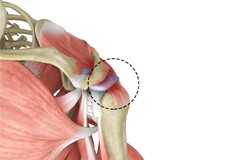
Rotator Cuff Pain
The rotator cuff consists of a group of tendons and muscles that surround and stabilize the shoulder joint. These tendons allow a wide range of movement of the shoulder joint across multiple planes. Irritation or injury to these tendons can result in rotator cuff pain.
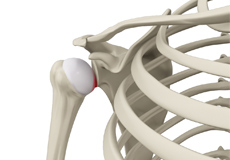
Subluxation
The shoulder is a highly mobile ball and socket joint. The ball of the upper arm bone (humerus) is held in place at the socket (glenoid) of the shoulder blade (scapula) by a group of ligaments. A partial dislocation of the shoulder joint is termed as a subluxation. This means the ball has partially moved out of the glenoid as opposed to a dislocation, where the ball completely moves out of the glenoid.

Shoulder Impingement
Shoulder impingement is the inflammation of the tendons of the shoulder joint. It is one of the most common causes of pain in the shoulder. Shoulder impingement is also called swimmer’s shoulder, tennis shoulder or rotator cuff tendinitis.

SLAP Tears
The term SLAP (superior –labrum anterior-posterior) lesion or SLAP tear refers to an injury of the superior labrum of the shoulder.
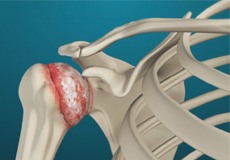
Arthritis of the Shoulder
The term arthritis literally means inflammation of a joint but is generally used to describe any condition in which there is damage to the cartilage. Damage of the cartilage in the shoulder joint causes shoulder arthritis. Inflammation is the body's natural response to injury.

Shoulder Instability
Shoulder instability is a chronic condition that causes frequent dislocation of the shoulder joint.
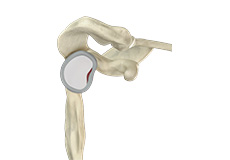
Shoulder Labral Tear
Traumatic injury to the shoulder or overuse of the shoulder (throwing, weightlifting) may cause the labrum to tear. In addition, aging may weaken the labrum leading to injury.
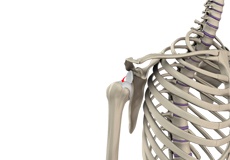
Shoulder Dislocation
Sports that involve overhead movements and repeated use of the shoulder at your workplace may lead to sliding of the upper arm bone from the glenoid. The dislocation might be a partial dislocation (subluxation) or a complete dislocation causing pain and shoulder joint instability.
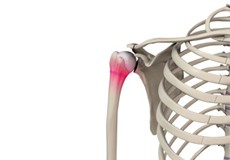
Little League Shoulder
The upper arm bone is called the humerus. It forms the shoulder joint at the upper end and elbows joint at the lower end. In children, the bone continues from a region called the growth plate, which is found at the ends of the bone. This is a region of cartilage cells, which are still soft. In time, they mature and harden to form the adult bone.
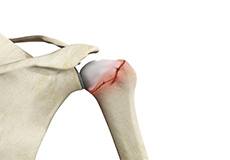
Shoulder Fracture
A break in a bone that makes up the shoulder joint is called a shoulder fracture.The shoulder is the most flexible joint in the body, enabling a wide range of movements. It is a ball-and-socket joint made up of three bones, namely the humerus (upper arm bone), scapula (shoulder blade) and clavicle.

Frozen Shoulder
Frozen shoulder, also called adhesive capsulitis, is a condition in which you experience pain and stiffness in your shoulder. The symptoms appear slowly, worsen gradually and usually take one to three years to resolve on their own.
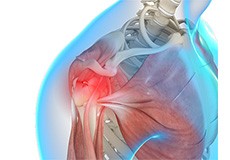
Shoulder Trauma
Shoulder injuries most commonly occur in athletes participating in sports such as swimming, tennis, pitching, and weightlifting. The injuries are caused due to the over usage or repetitive motion of the arms.

Clavicle Fracture
The break or fracture of the clavicle (collarbone) is a common sports injury associated with contact sports such as football and martial arts, as well as impact sports such as motor racing. A direct blow over the shoulder that may occur during a fall on an outstretched arm or a motor vehicle accident may cause the clavicle bone to break.
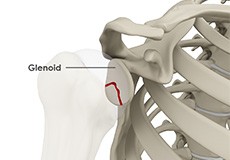
Glenoid Fractures
Fractures of the glenoid are rare but can occur due to major trauma or during high-energy sports activities.
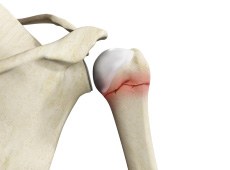
Proximal Humerus Fractures
The humerus is the bone that forms the upper arm. It articulates with the glenoid cavity of the scapula (shoulder blade) to form the shoulder joint and with the lower arm bones – the ulna and radius – to form the elbow joint. The proximal humerus is the upper end of the arm bone that forms the shoulder joint.
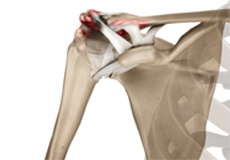
Acromioclavicular (AC) Arthritis
The acromioclavicular joint is part of the shoulder joint. It is formed by the union of the acromion, a bony process of the shoulder blade, and the outer end of the collar bone or clavicle. The joint is lined by cartilage that gradually wears with age as well as with repeated overhead or shoulder level activities such as basketball. The condition is referred to as AC arthritis or acromioclavicular arthritis.

Acromioclavicular (AC) Joint Osteoarthritis
Osteoarthritis also called degenerative joint disease, is the most common form of arthritis. It occurs most often in older people. AC joint osteoarthritis affects the tissue covering the ends of bones (cartilage) in the AC joint of the shoulder. The cartilage becomes damaged and worn out causing pain, swelling, stiffness and restricted movement in the AC joint.
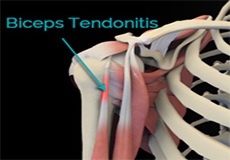
Proximal Biceps Tendinitis
Proximal biceps tendinitis is the irritation and inflammation of the biceps tendon at the shoulder joint. The biceps muscle is the muscle of the upper arm which is necessary for the movement of the shoulder and elbow.
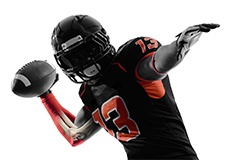
Throwing Injuries of the Shoulder
Throwing injuries of the shoulder are injuries sustained as a result of trauma by athletes during sports activities that involve repetitive overhand motions of the arm as in baseball, American football, volleyball, rugby, tennis, track and field events, etc.
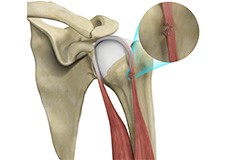
Bicep Tendon Rupture
The biceps muscle is located in the front side of your upper arm and functions to help you bend and rotate your arm.

Shoulder Labral Tear with Instability
The shoulder consists of a ball-and-socket joint formed by the upper end of the humerus (upper arm bone) and a cavity in the shoulder blade called the glenoid. The glenoid cavity is surrounded by a rim of cartilage called the labrum. The labrum adds depth to the cavity making the joint more stable and positions the ball within the socket.
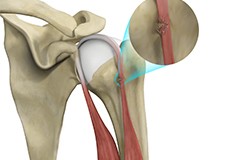
Proximal Biceps Tendon Rupture
The biceps muscle is the muscle of the upper arm which is necessary for the movement of the shoulder and elbow. It is made of a ‘short head’ and a ‘long head’ which function together. These are connected to the shoulder joint by two tendons called the proximal biceps tendons and to the elbow joint by a single distal biceps tendon.
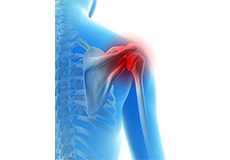
Baseball and Shoulder Injuries
Shoulder injuries in baseball players are usually associated with pitching. While this overhand throwing activity can produce great speed and distance for the ball, when performed repeatedly, can place a lot of stress on the shoulder. While pitching, the arm is thrown outward and backward to generate speed.

Sternoclavicular Joint (SC joint)
The sternoclavicular joint is the joint between the breastbone (sternum) and the collar bone (clavicle). The SC joint is one of the 4 joints that complete the shoulder and is the only joint that links the arm to the body. Like any other joints, the SC joint is covered by articular cartilage that helps the bones slide effortlessly against each other during arm and shoulder movement.
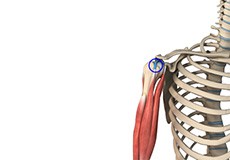
Long Head Biceps Tendon Rupture
Your biceps muscle has two heads, a long head, and a short head, which are both attached to the shoulder. The long head of the biceps tendon is a tough band of connective fibrous tissue that attaches the long head of the biceps to the top of the shoulder socket.
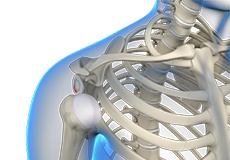
Multidirectional Instability of the Shoulder
Instability may be described by the direction in which the humerus is subluxated or dislocated from the glenoid. When it occurs in several directions it is referred to as multidirectional instability.

Massive Retracted Rotator Cuff Tear
A tear in the rotator cuff can cause pain and disability. It can occur from degeneration of the rotator cuff due to overuse or from a sudden injury. Massive rotator cuff tears involve tears in two complete tendons of the rotator cuff. A tear of more than 5 cm is described as massive.
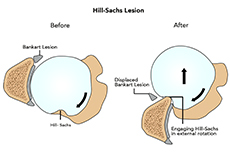
Hill-Sachs Lesion
Your shoulder consists of a ‘ball-and-socket joint’. The humerus (upper arm bone) has a rounded head (ball) that is attached to the glenoid cavity (socket) in the shoulder blade. Certain injuries can cause dislocation of the joint and damage to the humeral head. Damage to the back and outer portion of the humeral head can result in a defect called a Hill-Sachs lesion.

Periprosthetic Shoulder Infection
A periprosthetic shoulder joint infection is a very rare, but devastating complication of shoulder replacement surgery characterized by infection of the tissues surrounding your shoulder prosthesis.

Periprosthetic Shoulder Fracture
A periprosthetic shoulder fracture is a fracture that occurs in the bone adjacent to a shoulder prosthesis.
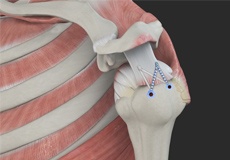
Rotator Cuff Repair
Rotator cuff repair is a surgery to repair an injured or torn rotator cuff. It is usually performed arthroscopically on an outpatient basis. An arthroscope, a small, fiber-optic instrument consisting of a lens, light source, and video camera. The camera projects images of the inside of the joint onto a large monitor, allowing your surgeon to look for any damage, assess the type of injury and repair it. Large rotator cuff tears may require open surgery.

Shoulder Arthroscopy
Arthroscopy is a minimally invasive diagnostic and surgical procedure performed for joint problems. Shoulder arthroscopy is performed using a pencil-sized instrument called an arthroscope. The arthroscope consists of a light system and camera that projects images of the surgical site onto a computer screen for your surgeon to clearly view.
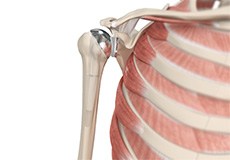
Shoulder Joint Replacement
Total shoulder replacement surgery is performed to relieve these symptoms. In this surgery, the damaged articulating parts of the shoulder joint are removed and replaced with artificial prostheses. Replacement of both the humeral head and the socket is called a total shoulder replacement.
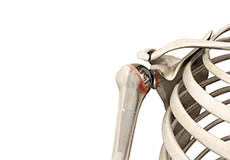
Revision Shoulder Replacement
Total shoulder replacement usually has good results, but a revision surgery may occasionally be necessary due to persistent pain, infection, stiffness, weakness, instability, hardware loosening, malposition or fracture.

Reverse Shoulder Replacement
Conventional surgical methods such as total shoulder joint replacement have been shown to be significantly ineffective in the treatment of rotator cuff arthropathy. Reverse total shoulder replacement is an advanced surgical technique specifically designed for rotator cuff tear arthropathy, a condition where you suffer from both shoulder arthritis and a rotator cuff tear.
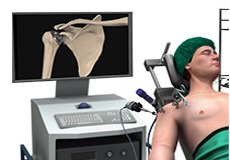
Minimally Invasive Shoulder Joint Replacement
Shoulder joint replacement is a surgical procedure that replaces damaged bone surfaces with artificial humeral and glenoid components to relieve pain and improve functional ability in the shoulder joint.
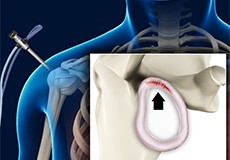
Labral Repair
Labrum repair is a surgical technique recommended for treating labrum tear. Labrum is a triangular, fibrous, rigid cartilage structure lining the ball-and-socket joint of the shoulder. It provides cushioning support to these two joints. It also deepens the socket and helps to stabilize the joint.
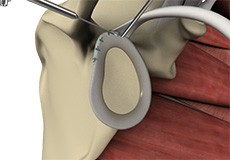
SLAP Repair
A SLAP tear can be treated through an arthroscopic surgical procedure called a SLAP repair.

Bicep Tendon Rupture at Shoulder
Overuse and injury can cause fraying of the biceps tendon and eventual rupture. A biceps tendon rupture can either be partial, where it does not completely tear the tendon or complete, where the tendon completely splits in two and is torn away from the bone.
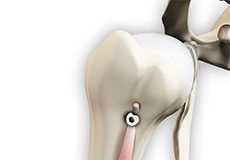
Proximal Biceps Tenodesis
Proximal biceps tenodesis is the surgical reattachment of a torn proximal biceps tendon, which connects the upper part of your biceps muscle to the shoulder.
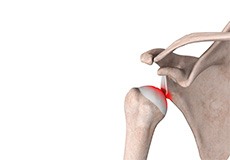
Shoulder Stabilization
Shoulder stabilization surgery is performed to improve stability and function to the shoulder joint and prevent recurrent dislocations. It can be performed arthroscopically, depending on your particular condition, with much smaller incisions.
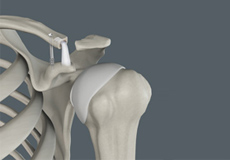
Acromioclavicular Joint (AC) Joint Reconstruction
The acromioclavicular (AC) joint is one of the joints present within your shoulder. It is formed between a bony projection at the top of the shoulder blade (acromion) and the outer end of the clavicle (collarbone). The joint is enclosed by a capsule and supported by ligaments.
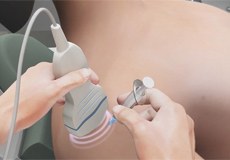
Ultrasound-Guided Shoulder Injections
An ultrasound-guided injection is a minimally invasive procedure used for treating various painful musculoskeletal conditions such as tendonitis, bursitis, and neuritis
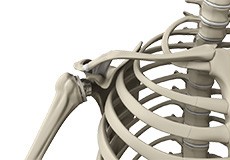
Intraarticular Shoulder Injection
The shoulder is prone to different kinds of injuries and inflammatory conditions. An intraarticular shoulder injection is a minimally invasive procedure to treat pain and improve shoulder movement. It may be performed with the help of ultrasound or fluoroscopic imaging which allows your physician to precisely target the intraarticular space.
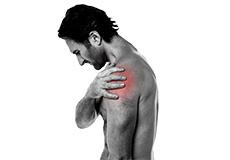
Failed Shoulder Surgery
Failed shoulder surgery is a surgery that did not meet expectations and resulted in recurring pain or other unwanted symptoms. All surgeries are associated with risks, some have a higher risk than others. The most commonly reported failed shoulder surgeries include rotator cuff repairs and shoulder stabilization for shoulder instability.
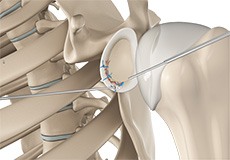
Arthroscopic Bankart Repair
Bankart surgery can be performed by a minimally invasive surgical technique called arthroscopy.During an arthroscopic Bankart procedure, your surgeon makes a few small incisions over your shoulder joint.
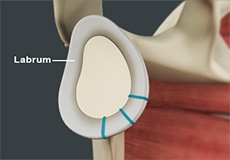
Shoulder Labrum Reconstruction
The shoulder joint is a ball and socket joint. A ball at the top of the upper arm bone (the humerus) fits neatly into a socket, called the glenoid, which is part of the shoulder blade (scapula). The labrum is a ring of fibrous cartilage surrounding the glenoid, which helps in stabilizing the shoulder joint.
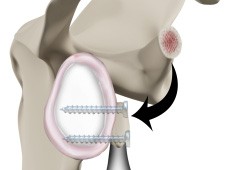
Latarjet Procedure
The shoulder joint provides a wide range of movement to the upper extremity, but overuse or trauma can cause instability to the joint. The Latarjet procedure is a surgical procedure performed to treat shoulder instability by relocating a piece of bone with an attached tendon to the shoulder joint.
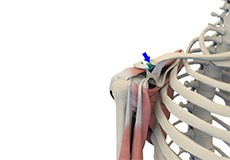
Distal Clavicle Excision
Distal clavicle excision is a procedure which involves removal of the outer end of the clavicle (collarbone) to treat shoulder pain and disability due to arthritis or impingement.
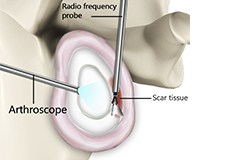
Capsular Release
A capsular release of the shoulder is surgery performed to release a tight and stiff shoulder capsule, a condition called frozen shoulder or adhesive capsulitis. The procedure is usually performed arthroscopically through keyhole-size incisions.
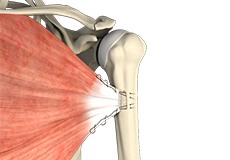
Pectoralis Major Tears/Repairs
The pectoralis muscle is a large fan-shaped muscle comprised of the pectoralis major and pectoralis minor muscles that stretch from the armpit to the collarbone and down across the lower chest region on both sides of the chest. The two sides of the chest connect at the breastbone or sternum.
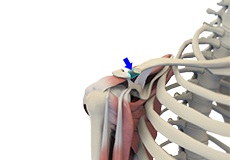
Mumford Distal Clavicle Excision
A Mumford distal clavicle excision is a surgical procedure which involves excision or resection of the outer (distal) end of the clavicle, also called the collar bone.

ORIF of the Clavicle Fractures
ORIF/open reduction and internal fixation is a surgical procedure employed for the treatment of a clavicle fracture not amenable to non-surgical conservative treatment.A clavicle fracture refers to a broken collarbone and is a common injury associated with contact sports such as football and martial arts, as well as impact sports such as motor racing.
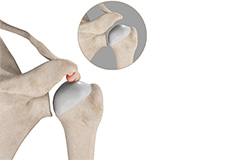
Subacromial Decompression
Subacromial decompression is a surgical procedure performed for the treatment of a condition called shoulder impingement. In shoulder impingement, the degree of space between the rotator cuff tendon and shoulder blade is decreased due to irritation and swelling of the bursa or due to development of bone spurs.
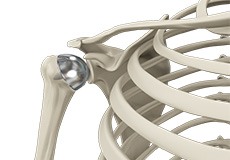
Shoulder Resurfacing
The shoulder is an active joint is prone to injuries and may also get affected by conditions such as arthritis, which results in impaired functioning and related discomfort. The traditional method of treatment for such conditions is shoulder joint replacement.

Arthroscopic Acromioplasty
Acromioplasty is the surgical removal of a small part of the surface of the acromion (bony process on your shoulder blade). The shoulder joint is made up of a ball and socket joint, where the head of the humerus (upper arm bone) articulates with the socket of the scapula (shoulder blade), which is called the glenoid.
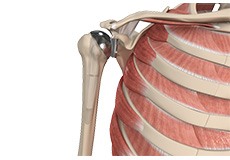
Am I a Candidate for Shoulder Replacement?
Shoulder replacement is a surgical procedure where the damaged parts of your shoulder are removed and replaced with artificial parts known as prostheses.
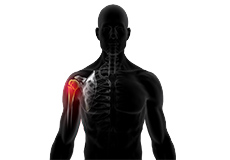
Shoulder Fracture Care
A break in the bone that makes up the shoulder joint is called a shoulder fracture. The clavicle (collarbone) and end of the humerus (upper arm bone) closest to the shoulder are the bones that usually are fractured. The scapula, or shoulder blade, is not easily fractured because of its protective cover of surrounding muscles and chest tissue.
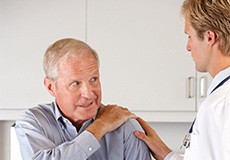
Am I a Candidate for Shoulder Surgery?
More people are considering shoulder surgery to manage shoulder problems thanks to advances in technology and equipment. Surgery is now minimally invasive and can be performed on an outpatient basis with faster recovery and fewer complications.

Virtual Implant Positioning by Arthrex
The VIP (Virtual Implant Positioning) system by Arthrex is a web-based system onto which patient data and CT scan images can be easily uploaded. No software needs to be downloaded. It allows your surgeon to accurately position the implant components utilizing planning software and guidance instrumentation when performing shoulder arthroplasty.






